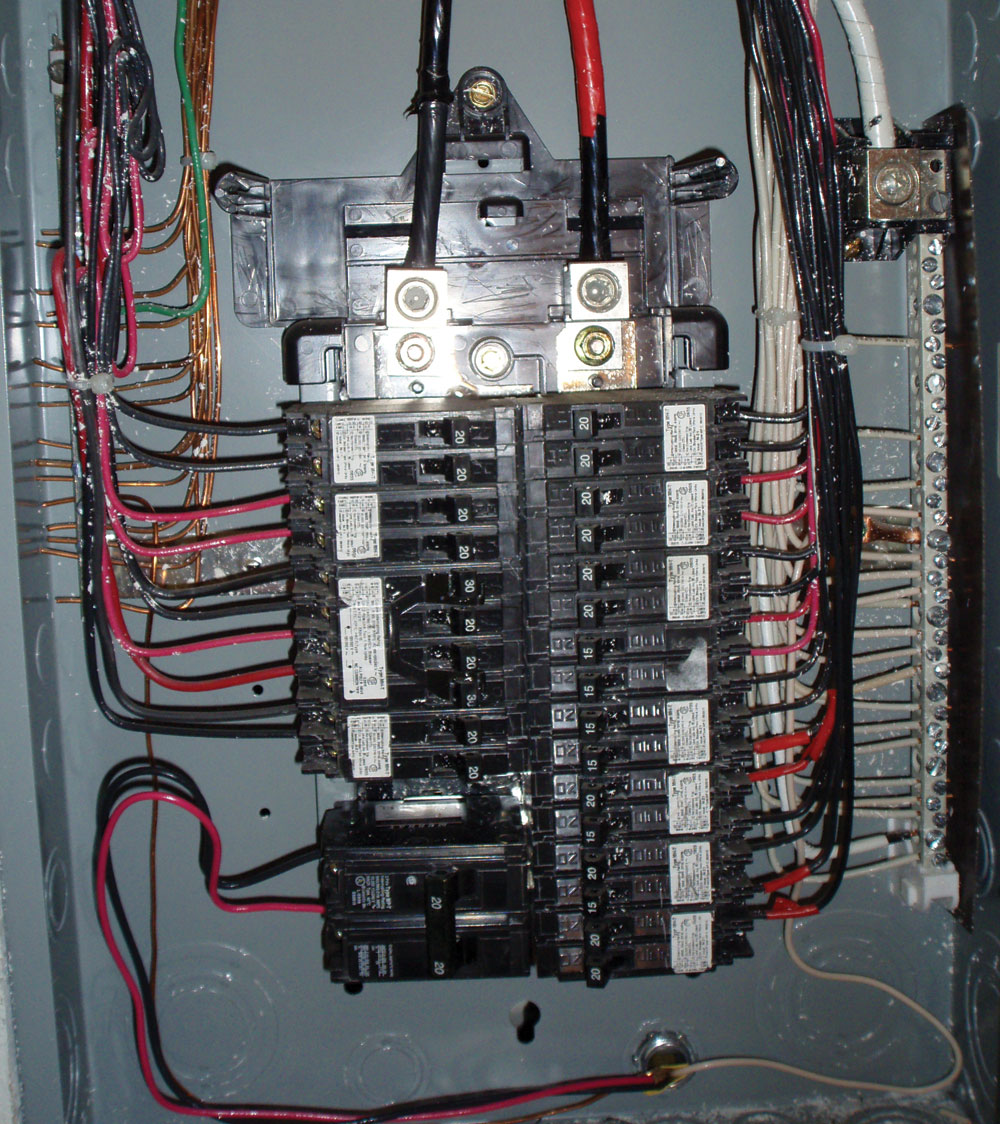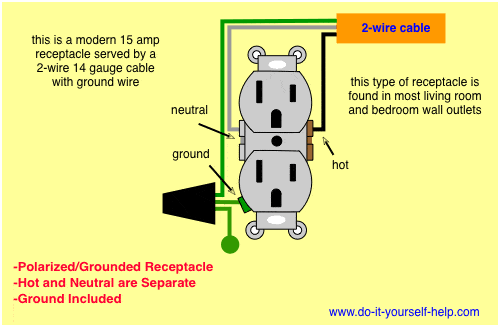Monday November, 20
Home Electrical
Student Learning Objectives
- Describe how alternating current is produced
- Describe frequency, amplitude and period in regards to a sine wave
- Construct a simple circuit of a switch and light with AC
- Construct a circuit of an duplex outlet with AC
- Understand possible career opportunities in a the electrical field
Vocabulary
Alternating current -is any any current that reverses its direction of power at regular intervals
Frequency -number of cycles per second
Electricity deserves respect. You should take safety precautions when working around it, obtain proper permits, and pay strict attention to all code requirements. This does not mean that electricity is some mystery or that it is unpredictable. There are many careers and times in your life where a basic understanding of electricity will pay dividends.
Is this what I sound like when I teach electronics?
Related Articles
Safety and Electricity: Helpful Reminders
Electrical Safety Gloves: Inspection and Classification
Electrical Safety Summary
Lockout/Tagout Systems and Standards
Related Categories
Lineman Gloves
Insulated Tool Sets
Electrical SafetyQuick Tips #266Electricity is a potent source of energy that powers lights, tools, machinery and many other devices necessary for our day-to-day work. Electricity can also be a hazard causing injury or death. Experts in the electrical industry look to the National Fire Protection Association’s (NFPA) 70: National Electric Code (NEC) for electrical design, installation and inspection safety standards. The NFPA 70: NEC is adopted in all 50 states and addresses commercial, residential and industrial occupancies.
The Occupational Safety and Health Administration (OSHA) recognized the importance of the NEC and included the 1971 edition into Subpart K of the 29 Code of Federal Regulations (CFR) 1926 for the construction industry. They have since updated, revised and clarified the standard to make it more flexible in order to eliminate the need for the constant revision to keep pace with the NEC, which is updated every three years.
For general industry, electrical standards are found in 29 CFR 1910 Subpart S. The electrical installation standards found in Subpart S were revised in February, 2007 and became effective on August 13, 2007. Some of the requirements of sections 29 CFR 1910.303 through 1910.308 do not apply to all electrical installations. It can be difficult to determine which requirements apply to the installation based on the time period in which the equipment was built or last modified. To remedy this problem OSHA has developed an interactive eTool designed to assist employers in determining what regulations applies to them based on the date of installation or modification of the equipment.
Electricity and Its Effects on the Body n order for electricity to flow, a complete circuit made of a conductor, a load or electricity-consuming device and a ground is needed. Electricity will flow through the conductor to the load and finally to the ground to complete the circuit. Electricity will follow the path of least resistance to ground—similar to water in a pipeline that flows out of a valve when it is opened. Electricity becomes dangerous when you become part of the circuit, because the closest path to ground may be through you, causing an electrical shock.
When shocked, your muscles contract. If the lungs are involved in the path, voluntary respiration can be halted. If the heart is involved, fibrillation can occur resulting in heart failure. As little as 50 milliamperes can cause death. It is important to realize that an electrical shock may not be strong enough to cause a fatality but it could cause you to fall from heights or in to dangerous surroundings. For details on the effects electricity has on the body, see Table 1.
Qualified Personnel versus Unqualified Personnel 29 CFR 1910 Subpart S identifies two types of people that may come in to contact with electrical equipment on a jobsite: qualified and unqualified. A qualified person is one who has been trained to avoid electrical hazards when working on or near exposed energized parts and is:
- Familiar with the safety-related work practices required in 29 CFR 1910.331-1910.335
- Aware of the skills and techniques necessary to distinguish exposed live parts of electrical equipment
- Knowledgeable of the skills and techniques used to determine the nominal voltages of exposed parts
- Cognizant of the clearance distances specified in 29 CFR 1910.333(c) and the corresponding voltages to which the qualified person will be exposed
Electrical Safety Practices at Work Safe work practices are used to prevent electrical shock or similar injuries by keeping workers away from energized equipment or circuits and by training qualified workers on the correct procedures when working on energized equipment or circuits. Prior to using or performing maintenance on electrical equipment, the employee should first determine if it is safe by checking the following:
- Verify that electrical equipment is not located in a hazardous environment, such as a damp/wet location or where it is exposed to high temperatures and flammable gases and vapors
- Make sure overcurrent and safety devices, such as fuses, circuit breakers and ground fault circuit interrupters (GFCI), have not been tampered with and are working correctly
- Inspect the power cord and plug to ensure there are no defects, such as cuts in the insulation exposing bare wiring
- Identify if the equipment has an emergency shutoff switch and where it is located prior to use
- Make sure there is sufficient space around the electrical equipment or circuit to allow for operation and maintenance
- Remove all personal metal jewelry prior to using or working on electrical equipment or circuits
- De-energize electrical equipment before testing or repairing in accordance with the Lockout/Tagout standard 29 CFR 1910.147.
- If de-energizing the electrical equipment or circuit will increase the potential for an electrical hazard or is necessary for testing and troubleshooting, the appropriate tools and personal protective equipment (PPE) must be used and worn.
Electrical Protective Equipment Electrical protective equipment, also known as insulating equipment, includes items such as insulated blankets, matting, covers, line hose, gloves, sleeves, face shields and arc flash clothing. Blankets, gloves and sleeves are clearly marked with class and type, while clothing is labeled with an arc thermal performance value rating (ATPV) measured in calories per square centimeter (i.e. 65 cal/cm²). The ATPV rating identifies the amount of energy that can be delivered to a point at a particular distance from an arc flash. The higher the number, the more protection offered. The class refers to the maximum-use voltage. Insulating must not exceed maximum-use voltages (see Table 2). The type refers to ozone resistance. Type I is not ozone resistant. Type II is ozone resistant.
Insulated equipment should be inspected prior to each day's use and immediately following an incident that may have caused damage. Damage consists of holes, tears, cuts, punctures, ozone cutting, embedded foreign objects, swelling, softening, hardening or any other defect. Once an insulated piece of equipment is removed from service, it may not be reused until it has been retested and certified. All electrically insulated equipment must also be retested and certified periodically. See Table 3 for testing intervals.
Employee Training Electrical safety is the responsibility of everyone on the jobsite. It is important to establish a hazard assessment program that includes employee training on electrical safety. Training employees on the basics of electrical safety should include its effects on the body, first aid procedures when someone is shocked, how to fight an electrical fire and how to identify hazards. Some do's and don’ts that can assist in electrical safety training include:
DO'S
- Read and follow electrical equipment instruction manuals prior to using
- Use safety signs, barricades and tags to identify and protect electrical equipment
- Only use extension cords as a temporary solution
- Use waterproof cords in an outdoor application
- Contact a certified electrician when electrical repair is needed
- Overload outlets by using splitters
- Touch electrical equipment, including power cords with wet or damp hands
- Allow dirt, grease or dust to accumulate on electrical equipment
- Use temporary wiring in place of permanent wiring
- Use cords or equipment that are not properly grounded
Q. Does insulated equipment need to be approved or certified?
A. Yes, insulated equipment must be certified by the manufacturer to be suitable for the specified conditions to which they are exposed. The certificate identifies the equipment and the date tested.
Q. Is there an expiration date for insulated equipment after which it must be taken out of service and destroyed?
A. No. As long as the insulated equipment is in a safe, reliable condition and retested periodically as required by 29 CFR 1910.137, it may continue to be used. (See Table 3.)
Q. Where can I find out what level of personal protection I need to wear when working on energized equipment?
A. The NFPA 70E-2015: Standard for Electrical Safety in the Workplace includes a table that identifies what level of personal protective equipment should be worn when working on energized equipment or circuits.
SourcesOSHA Subpart S – Electrical Standard eTool
OSHA's Controlling Electrical Hazards
2015 NEC
29 CFR 1910 Subpart S
29 CFR 1910.137
29 CFR 1910.147
Quick Tips #263 NFPA 70E: Electrical Safety Summary
Winburn D.C. Practical Electrical Safety. Marcel Dekker, INC. 1988
Table 1: Effects of Electric Current in the Human Body
CurrentReaction
Below 1 milliampereGenerally not perceptible
1 milliampereFaint Tingle
5 milliamperesSlight shock felt; not painful but disturbing. Average person can let go, Strong involuntary reactions can lead to other injuries.
6-25 milliamperes (women)Painful shock, loss of muscular control*
9-30 milliamperes (men)The freezing current or “let-go” range* Individual cannot let go, but can be thrown away from the circuit if extensor muscles are stimulated.
50-150 milliamperes3Extreme pain, respiratory arrest, severe muscular contractions. Death is possible.
1,000-4,300 milliamperesRhythmic pumping action of the heart ceases. Muscular contraction and nerve damage occur; death likely.
10,000 milliamperesCardiac arrest, severe burns; death probable
*If the entensor muscles are excited by the shock, the person may be thrown away from the power source.
Source: OSHA Controlling Electrical Hazards
Table 2: Class and Use Voltages
ClassMaximum
Use VoltageProof Test
(AC)Retest Voltage
(AC)Proof Test
(DC)Retest Voltage
(DC)
005002,5002,50010,00010,000
01,0005,0005,00020,00020,000
17,50010,00010,00040,00040,000
217,00020,00020,00050,00050,000
326,50030,00030,00060,00060,000
436,00040,00040,00070,00070,000
Source: OSHA CFR 1910.137
Table 3: Protective Equipment Test Schedules
Type of EquipmentWhen to Test
Rubber insulating line hoseUpon indication that insulating value is suspect and after repair
Rubber insulating coversUpon indication that insulating value is suspect and after repair
Rubber insulating blanketsBefore first issue and every 12 months thereafter* upon indication that insulating value is suspect and after repair.
Rubber insulating glovesBefore first issue and every 6 months thereafter* upon indication that insulating value is suspect and after repair; and after use without protectors.
Rubber insulating sleevesBefore first issue and every 12 months thereafter* upon indication that insulating value is suspect and after repair.
*If insulating equipment has been tested but not issued for service, it may not be placed into service unless it has been tested within the previous 12 months.
Source: OSHA CFR 1910.137
(Rev. 7/2016)
Please Note:
The information contained in this publication is intended for general information purposes only and is based on information available as of the initial date of publication. No representation is made that the information or references are complete or remain current. This publication is not a substitute for review of the current applicable government regulations and standards specific to your location and business activity, and should not be construed as legal advice or opinion. Readers with specific questions should refer to the applicable standards or consult with an attorney.



